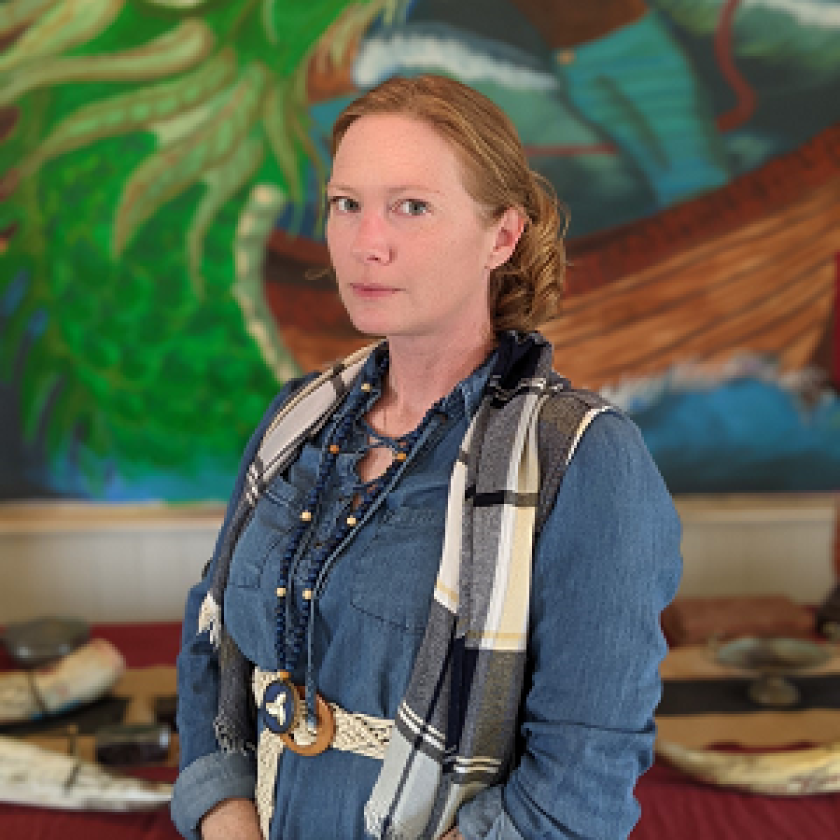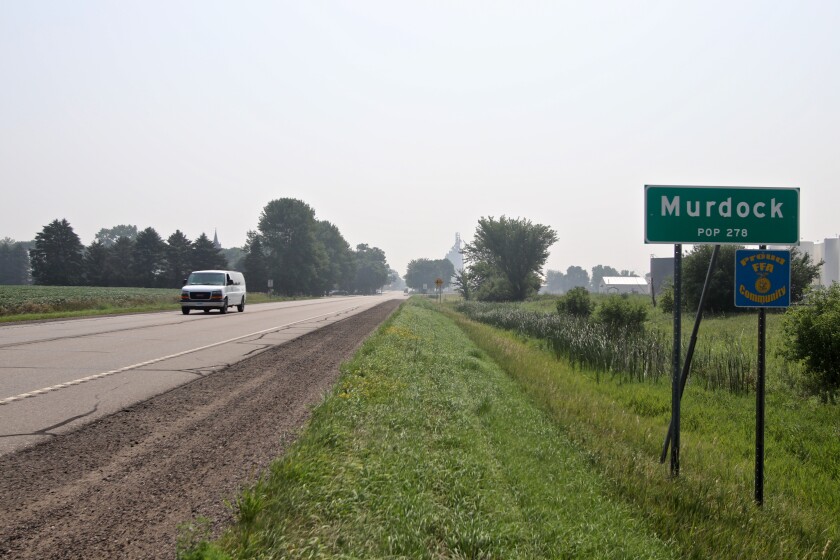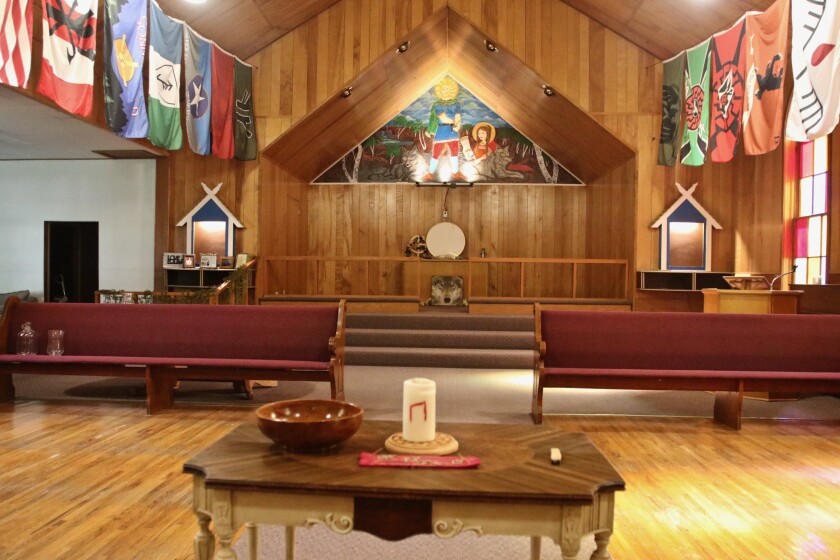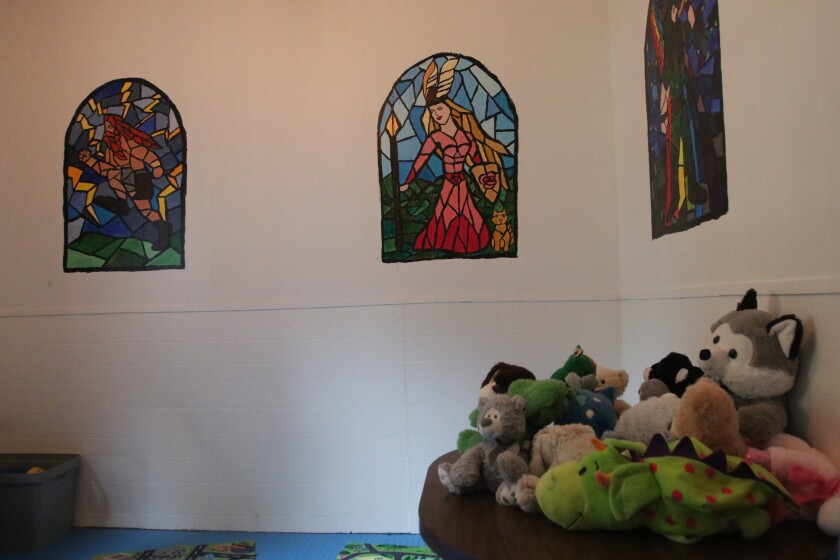MURDOCK, Minn. — From the outside, the old Calvary Lutheran Church resembles one of many abandoned structures scattered throughout the Dakotas and Minnesota. The church’s marquee sign is blank, but the grass is mowed, and construction materials lay in the yard.
The building is no longer Christian, but pagan. More specifically, a hof, dedicated to the son of Odin, Baldr, and his wife Nanna, a goddess associated with joy, peace and the moon. The cross atop the steeple still stands, but it’s coming down soon and will be donated, said Brandy Callahan, a witan or top advisor from North Dakota within the Asatru Folk Assembly or AFA.
ADVERTISEMENT
Accompanied by two “worker bees,” officially called folk builders, Callahan opened Baldrhof’s doors. She and the two others are covered in Nordic tattoos. “We have nothing to hide here. We are a modern people creating a modern tradition,” she said.
Callahan knows the AFA, an officially recognized religion in Iceland, is listed as the only hate group with members in North Dakota by the , a law firm that tracks extremism. , including the AFA.
Callahan denies they’re a hate group; she’s just trying to protect her culture, she said.
When asked directly if the hof will accept members of ethnic backgrounds other than white, her answer was simple.

“No, we don’t allow Black people. Does that mean a Black person can’t come into our church or to our events? Of course not. Our religion is based on our shared ancestry,” said Callahan, who drives about eight hours from North Dakota to the hof every time she goes.
ADVERTISEMENT
The AFA has a hof in Brownsville, California, and another in Linden, North Carolina. To establish its third hof, the group purchased and moved into the church along Main Avenue in Murdock, Minnesota, population 278, in the summer of 2020. They chose the town, which sits 115 miles west of Minneapolis, because it’s central to surrounding states such as North Dakota, South Dakota, Wisconsin, Illinois and elsewhere.
Religious institutions like the AFA are able to discriminate because of a First Amendment rule created by the courts known as the ministerial exception. In essence, the that prevents lawsuits aimed at discrimination by religious institutions.
Residents in the area, some of whom wished to remain unnamed, jokingly called the AFA the “Avenger church,” and hoped they would leave.

Ben Erickson lives about five blocks away, near the Church of the Sacred Heart. He doesn’t have a problem with the Asatru hof.
“As long as they don’t come knocking on my door, they don’t bother me and I don’t bother them,” said Erickson, who's lived in Murdock for seven years. He believes the hof's doctrine of not allowing people of color to become members is extreme.
ADVERTISEMENT
"They toe the line," Erickson said.
The hof in Murdock has received its share of threats because of its beliefs.
“We’ve gotten death threats. People have threatened to lock us in this church and set it on fire, women and children. And yet they call us a hate group. That’s when the wolves come in when we’re struggling and this tells us we have to bind together,” Callahan said.
“This is our everyday. This is what we live. But you will not see any of us turning around and acting that way. We’re not victims to these things,” Callahan said.

What is Asatru?
The Anti-Defamation League describes Asatru as a pre-Christian religious belief that isn’t necessarily racist on its own, but appeals to white supremacists as a “warrior religion” and stands in stark contrast to the more pacifist religion Christianity, which descended from Judaism.
ADVERTISEMENT
Asatru followers describe themselves as racialist, tribal or folkish. Callahan pointed to the church’s symbol, a gray wolf painted on the wall behind where a pulpit would usually stand. She said every AFA church or hof has a representative animal.
Two large drinking horns rest on a table near where a Christian pastor would usually prepare communion. Members have used the horns communally even during the coronavirus pandemic, Callahan said. Pews are lined up in a square where the Lutheran congregation used to sit. The formation is as close as Callahan could get to arranging a circle.
“Our traditions are sacred. Every culture is sacred, and it doesn’t matter if it’s Native or African or anything else. It’s important to hold onto our cultural heritage, because without roots our people will die,” Callahan said.
Joanna Mendelson, associate director of the Anti-Defamation League's Center on Extremism, said groups like the AFA always look for someone to blame for their problems.
“North Dakota has really low levels of extremist activity compared to other parts of the country. We do not see it in any shape or form as a hotbed. However, there are examples that have taken place around the state asking the community to rise up and fight back, whether or not it’s the vandalism of mosques or the dissemination of white supremist propaganda,” Mendelson said.
“Some of the efforts that you see may be taking place in North Dakota, although far and few between, resonate with this larger national landscape of what we’re seeing. This kind of depiction or this notion of us versus them, and some of the white supremacist narrative of feeling isolated and in many extreme cases are carried to a feeling of genocide and facing an existential threat that impacts their future,” she said.
“It is a larger paranoid fear and victimization that their race is under attack,” Mendelson said.
ADVERTISEMENT

'I felt it in my bones'
Callahan said the AFA, specifically the nearly 70 members of Baldrhof, keep politics and religion separate. Some hofs are open to accepting people from different cultures, but Baldrhof will not. She doesn’t ask about political stances, although potential members are thoroughly screened before admittance.
At times, Asatru churches have had white supremacist members who have turned to violence. In 2015, , some of whom claimed to be AFA members, who were accused of trying to start a race war by targeting churches and synagogues.
Callahan believes Asatru members with some extremist beliefs can and should be changed for the better from within the religion.
“This is a church, not a political place. If they are part of this tradition, then give them a model to live by,” Callahan said, adding that she has turned white supremacists away from joining Baldrhof.
ADVERTISEMENT

“People on the outside expect us to hold rallies. No, we don’t do that. We care more about doing our blot service, and go downstairs to eat. Feasting, breaking bread with others is a very big thing we do,” Callahan said.
A blot, which literally means blood sacrifice, isn’t about pagan rituals anymore, but it’s focused on members sacrificing their time for their faith, she said.
“I don’t know where that word hate comes from,” said Ashley McStocker, a folk builder for the AFA. She came to the hof in late July to help with renovations. “The SPLC is the mafia, they aren’t a law center.”
Raised Catholic, McStocker turned to the AFA last summer after reading news reports about Baldrhof.
“I’m just one of those curious people and I want to know why,” McStocker said. “And it was the first time I felt a real connection. It’s true emotion without any guilt, one of the most pure things I’ve ever experienced.”
Nathan Erlandson, another folk builder who organizes events, said paganism answered questions he had been asking since he was a young child.
“I felt it in my bones,” Erlandson said. “That’s a common phrase with the people here. They feel they are coming home.”








